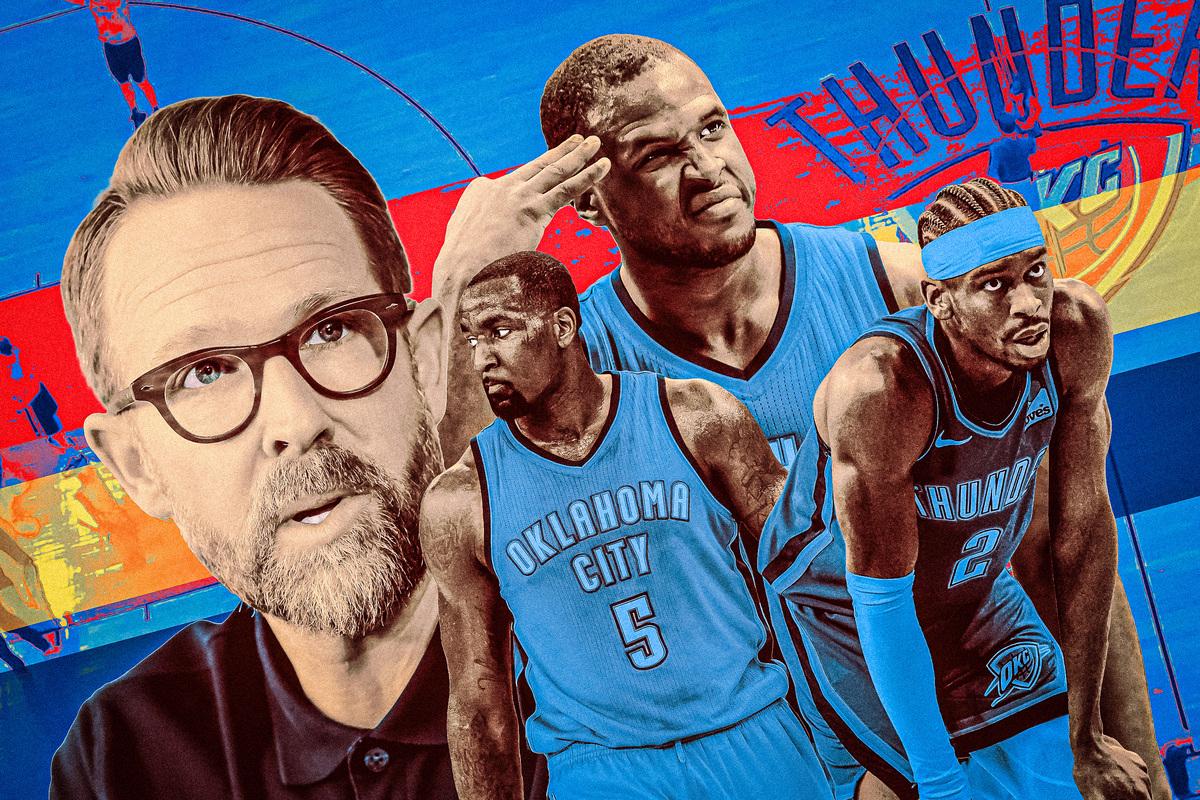
The Oklahoma City Thunder are the most interesting team in the NBA this week, because they’re both really good already (35-15, tied for first in the West) and full of potential to make major upgrades before Thursday’s trade deadline. The Thunder rank 29th in our All In-dex ranking, with the most future draft capital of any team. They have so many future picks that they could trade five unprotected first-rounders in a win-now overpay and still rank near the top of the draft equity leaderboard.
But the question is whether Thunder general manager Sam Presti will actually feel compelled to improve his roster this week—and if so, by how much. Perhaps he’d rather not tinker with the youngest roster in the league before he observes how it competes on the playoff stage.
We have years of history detailing Presti’s transactional tendencies, though. So let’s go season-by-season from 2009-10 through 2019-20, when the Thunder finished with a winning record every year, to analyze the midseason trades Presti made—and didn’t make. Then we can determine what we can learn about his habits, how they have evolved over time, and how they could affect this deadline.
2009-10
The situation: The Thunder were young, fun, and healthy. Kevin Durant, in his third season, was a first-time All-Star and the NBA’s scoring leader. Russell Westbrook, in his second season, was growing into a point guard role. Four of the team’s five starters played all 82 games. The league’s youngest team wasn’t a juggernaut, but it was rapidly improving: After completing a minor trade in December, the Thunder were up to the no. 5 spot in the West by deadline day, but didn’t make any further additions.
In: Eric Maynor, Matt Harpring’s salary
Out: Draft rights to Peter Fehse
The lesson: Presti won’t add to his young core too early if he doesn’t think his team is ready to contend yet. See, also, his comment before the 2023-24 season that “we have to finish our breakfast before we start acting like we’re on the cusp of something.”
Of course, the Thunder’s performance thus far suggests their breakfast has already been devoured and digested, and now they might really be on the cusp of something. But the 2009-10 precedent suggests that Presti might still want to see how his inexperienced players perform in their first playoff run before doing anything to shake up the existing dynamic.
2010-11
The situation: Again the NBA’s youngest team—I’m sensing a pattern in OKC—the Thunder were even better in year two of the Durant, Westbrook, and James Harden trio. At the deadline, they were 36-20 and holding the West’s no. 4 seed.
In: Kendrick Perkins, Nate Robinson, Nazr Mohammed
Out: Jeff Green, Nenad Krstic, Morris Peterson, D.J. White, first-round pick, second-round pick
The lesson: Presti isn’t afraid to trade a theoretical core player for what he perceives as a better fit for the roster.
In retrospect, of course, the Thunder should have started a Durant-Green-Serge Ibaka frontcourt, which would have been ideally suited for the small-ball strategy that would soon take the league by storm. Imagine a lineup with that trio plus Westbrook and Harden in the backcourt, all entering their prime ages together.
At the time, though, Presti’s effort to upgrade the center position—where Krstic had been starting—made sense, even if it cost Green, the no. 5 pick four years earlier, who was doubling Perkins’s scoring output. This was still a time of big men in the NBA. The Lakers, with a frontcourt of Pau Gasol, Andrew Bynum, and Lamar Odom, had reached three NBA Finals in a row. The top-seeded Spurs started DeJuan Blair or Antonio McDyess next to Tim Duncan. The eventual champion Mavericks had Tyson Chandler and Dirk Nowitzki.
Despite that logical philosophy, the trade ultimately didn’t result in an Oklahoma City title. The Thunder reached the Finals with Perkins in 2011-12 but never returned, and offensively limited centers soon fell out of fashion. As Durant teased Perkins on Twitter a few years ago, the now-ESPN analyst “averaged a whopping 2 and 3 during [OKC’s playoff loss in 2013]. U played hard tho champ lol.”
Translated to 2023-24, could Josh Giddey—the no. 6 pick three years ago—fill the Green role as the most expendable member of the core if Presti finds a better, bigger fit on a roster that could use more size? That extra size could manifest in the form of a center next to Chet Holmgren, or—as I’d prefer—a bigger wing in OKC’s frontcourt, which seems more of an area of need than another playmaking guard next to MVP candidate Shai Gilgeous-Alexander.
2011-12
The situation: By the 2012 trade deadline—delayed until March that year, due to the lockout—the Thunder had been the no. 1 seed every day for more than two months.
Trades: None
The lesson: The Thunder don’t need to make trades to be competitive in the playoffs. The 2011-12 version that stood pat at the deadline reached the Finals, after all. This conclusion is actually true of most Finals teams, which only rarely take big in-season swings.
2012-13
The situation: After trading Harden for Kevin Martin, Jeremy Lamb, and a trio of future picks (two first-rounders, one second) just before the start of the season, the reigning Western Conference champions held the no. 2 seed at the deadline.
In: Ronnie Brewer, draft rights to Georgios Printezis
Out: Eric Maynor, second-round pick
The lesson: Don’t trade a future MVP to save on luxury tax payments down the road. Money shouldn’t be a concern for OKC in 2023-24: The Thunder are well below the tax line this year and, given the roster’s youth, should remain there for the next several seasons, until all their young’uns graduate from their rookie deals and start getting expensive.
But at some point, a small-market team like the Thunder will have to consider the cap, especially with the new CBA’s more punitive restrictions for teams that exceed certain monetary thresholds. Logically, again, Giddey is the most expendable member of the core, as Holmgren and Jalen Williams seem like natural candidates for long-term extensions alongside SGA. Perhaps that foreknowledge will inspire Presti to trade Giddey before that point. Or perhaps he’s so scarred by the Harden trade—not that Giddey is a future MVP or anywhere near Harden’s level as an offensive talent—that he’d be afraid to make the same mistake twice.
2013-14
The situation: The Thunder were cruising at the 2014 trade deadline, even though Westbrook had missed nearly two months due to knee surgery. (He’d return to the starting lineup on the day of the deadline.) With Durant en route to the MVP trophy, OKC sat in first place every day in February.
In: Two second-round picks
Out: Ryan Gomes
The lesson: I’ll quote Bill Simmons, who saw a pattern in the Thunder’s operations and wrote on the day of the 2014 deadline: “What a shocker—wait, the Thunder cheaped out, avoided the luxury tax and decided to ‘go with what they had’? Who saw that coming?”
A few months later, OKC’s season ended in overtime in Game 6 of the Western Conference finals, with 39-year-old Derek Fisher playing in crunch time. The 2011-12 Thunder demonstrated that a team doesn’t need to make a midseason trade to reach the Finals. But the 2013-14 version demonstrated the downside of that conservative approach, especially when a contender might be one reliable role player short around its stars.
2014-15
The situation: Durant missed the first 17 games of the season due to a Jones fracture in his right foot, so the Thunder spent the first half stuck with a worse record than in any recent season. On the morning of the deadline, they sat in eighth place in the West—but looked like the stereotypical team nobody wants to face in the playoffs. They were still dominant when healthy, with a plus-10.7 net rating when Westbrook and Durant shared the court.
Perhaps in response to the previous season’s failure, or perhaps feeling the increased urgency to win with Durant before he reached free agency the following summer, Presti sought to improve his squad with the most active deadline of his career.
In: Dion Waiters, Enes Freedom (née Kanter), D.J. Augustin, Kyle Singler, Steve Novak, two second-round picks
Out: Reggie Jackson, Kendrick Perkins, Lance Thomas, Ish Smith, Latavious Williams, Grant Jerrett, Tibor Pleiss, two first-round picks, second-round pick
The lesson: Well, Durant suffered further foot complications and played his last game of the season on deadline day. The Thunder ended up missing the playoffs because they tied for the West’s eighth seed, but lost the head-to-head tiebreaker to the Pelicans. In the short term, all of Presti’s moves went for naught. (In the long term, too: Durant left for Golden State a year later, and the Thunder were stuck with “Can’t Play Kanter.”)
But the broader lesson here is that this represents Presti’s greatest deadline spree in more than a decade of configuring competitive Thunder rosters. Kanter was averaging 13.8 points per game for the Jazz when the Thunder traded for him—that’s the highest figure for any player Presti’s ever acquired at the deadline. If Kanter, Waiters, and Augustin are at the high end, it’s fair to say that Presti has never made a true blockbuster deal in the middle of a season.
There’s a first for everything, and Presti has obviously completed bigger deals in the offseason. But history suggests that the sort of massive, league-shaking move many fans are dreaming about is likely to remain hypothetical this week.
2015-16
The situation: In Durant’s final season before free agency, the Thunder trailed the dominant Warriors and Spurs, but were well ahead of every other team in the West. They might as well have not played any games for the final three-quarters of the season: They held the West’s no. 3 seed every day from December 3 onward.
In: Randy Foye
Out: D.J. Augustin, Steve Novak, two second-round picks
The lesson: There are those luxury tax savings again! Shedding Augustin and Novak’s contracts saved the Thunder nearly $10 million.
This deadline is more revealing of Presti’s philosophy for what he didn’t do: act because of Durant’s impending free agency. Maybe, in retrospect, he should have; might a better rotation player than Foye have helped the Thunder outlast the Warriors in the Western Conference finals, thereby keeping Durant in town?
Regardless, this possibility won’t apply to Presti’s new roster anytime soon. All the Thunder’s rotation players are signed through at least 2024-25, and SGA’s rookie extension takes him through 2026-27.
2016-17
The situation: Durant’s departure meant the 2016-17 season was the Russell Westbrook Show in OKC, as the Thunder star who stayed averaged a triple-double and won a contentious MVP debate. The Thunder held the no. 7 seed the morning of the deadline.
In: Taj Gibson, Doug McDermott, second-round pick
Out: Joffrey Lauvergne, Anthony Morrow, Cameron Payne
The lesson: When in doubt, Presti will trade for flawed wings who can help fill out a bench: Brewer, Singler, Foye, and McDermott all in a five-season span! The man has a type. (And the Thunder could use another veteran wing this season, if Presti pursues only minor transactions.)
2017-18
The situation: The Thunder were very active in the preceding offseason, trading for both Paul George and Carmelo Anthony. They hadn’t completely jelled by the deadline, though—and Anthony never would—and held the no. 5 seed.
Trades: None
The lesson: Presti doesn’t need to do all his trading during the season. It’s not just that he added George and Anthony during this one summer; he’s made almost all of his biggest trades during the offseason, as well, including trading away Harden, Ibaka, Anthony, George, Westbrook, and Chris Paul.
That tendency could mean that rather than pursuing a blockbuster this week, Presti might rather aim for starrier targets this offseason—especially around the draft, when OKC might receive lottery picks from the Rockets and Jazz—if his young team struggles in its first playoff showing.
2018-19
The situation: The 2018-19 Thunder were the franchise’s best since Durant’s departure—and still were until this year’s version. George finished third in MVP voting, and Westbrook averaged a triple-double for the third season in a row. Although OKC slumped down the stretch and was eventually eliminated from the playoffs by a Damian Lillard buzzer-beater, it sat in third place at the trade deadline.
In: Second-round pick
Out: Timothe Luwawu-Cabarrot
The lesson: Every couple years, OKC reminds the NBA world of its financial priorities: Parting with TLC’s small salary meant saving more than $7 million in luxury tax payments.
And while this criticism isn’t entirely fair, because Presti did seek offseason upgrades like George, it’s also notable that during the three seasons the Warriors had Durant, the Thunder didn’t make a single in-season splash, nor trade a single future pick for a win-now boost. Like many of the Warriors’ Western Conference competitors during this era—with Daryl Morey’s Rockets a notable exception—Presti largely bided his time until after the Golden State dynasty had been deposed.
This time-based concern shouldn’t influence Presti’s thinking now, even if the Nuggets’ entire championship-winning starting lineup is still intact. The NBA is relatively full of parity in the 2020s; no team has reached consecutive Finals since Durant’s Warriors half a decade ago.
2019-20
The situation: In the first Westbrook-less season in Oklahoma City, the Thunder were shockingly competitive, using a dynamic three-guard lineup with Paul, Gilgeous-Alexander, and Dennis Schröder to devastating effect. Given one of the league’s lowest projected win totals before the season, the Thunder were tied for the West’s no. 6 seed at the deadline—though they clearly treated the season as a gap year as they adjusted to their future-oriented outlook. In each of the next three seasons after 2019-20, OKC finished with a losing record.
In: Isaiah Roby
Out: Justin Patton
The lesson: Hey, they saved some more money toward the luxury tax!


